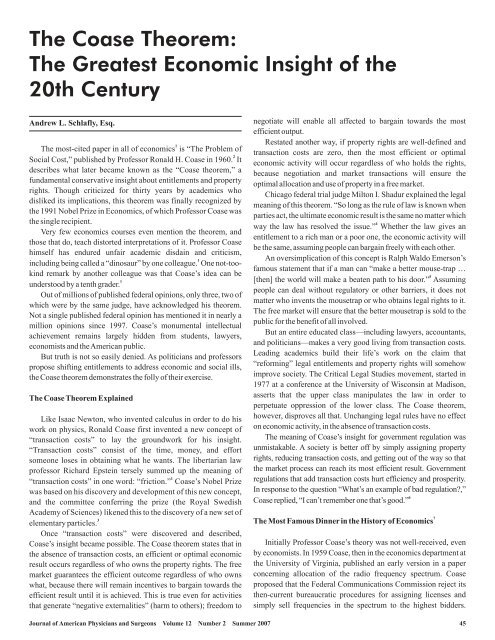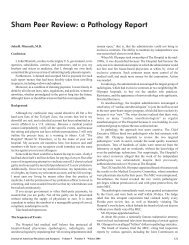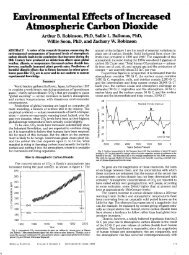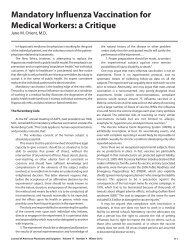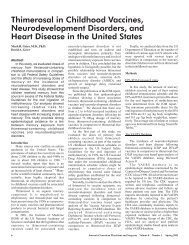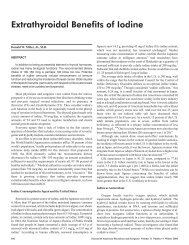The Coase Theorem: The Greatest Economic Insight of the 20th ...
The Coase Theorem: The Greatest Economic Insight of the 20th ...
The Coase Theorem: The Greatest Economic Insight of the 20th ...
You also want an ePaper? Increase the reach of your titles
YUMPU automatically turns print PDFs into web optimized ePapers that Google loves.
<strong>The</strong> <strong>Coase</strong> <strong>The</strong>orem:<br />
<strong>The</strong> <strong>Greatest</strong> <strong>Economic</strong> <strong>Insight</strong> <strong>of</strong> <strong>the</strong><br />
<strong>20th</strong> Century<br />
Andrew L. Schlafly, Esq.<br />
1<br />
<strong>The</strong> most-cited paper in all <strong>of</strong> economics is “<strong>The</strong> Problem <strong>of</strong><br />
2<br />
Social Cost,” published by Pr<strong>of</strong>essor Ronald H. <strong>Coase</strong> in 1960. It<br />
describes what later became known as <strong>the</strong> “<strong>Coase</strong> <strong>the</strong>orem,” a<br />
fundamental conservative insight about entitlements and property<br />
rights. Though criticized for thirty years by academics who<br />
disliked its implications, this <strong>the</strong>orem was finally recognized by<br />
<strong>the</strong> 1991 Nobel Prize in <strong>Economic</strong>s, <strong>of</strong> which Pr<strong>of</strong>essor <strong>Coase</strong> was<br />
<strong>the</strong> single recipient.<br />
Very few economics courses even mention <strong>the</strong> <strong>the</strong>orem, and<br />
those that do, teach distorted interpretations <strong>of</strong> it. Pr<strong>of</strong>essor <strong>Coase</strong><br />
himself has endured unfair academic disdain and criticism,<br />
1<br />
including being called a “dinosaur” by one colleague. One not-tookind<br />
remark by ano<strong>the</strong>r colleague was that <strong>Coase</strong>’s idea can be<br />
1<br />
understood by a tenth grader.<br />
Out <strong>of</strong> millions <strong>of</strong> published federal opinions, only three, two <strong>of</strong><br />
which were by <strong>the</strong> same judge, have acknowledged his <strong>the</strong>orem.<br />
Not a single published federal opinion has mentioned it in nearly a<br />
million opinions since 1997. <strong>Coase</strong>’s monumental intellectual<br />
achievement remains largely hidden from students, lawyers,<br />
economists and <strong>the</strong>American public.<br />
But truth is not so easily denied. As politicians and pr<strong>of</strong>essors<br />
propose shifting entitlements to address economic and social ills,<br />
<strong>the</strong> <strong>Coase</strong> <strong>the</strong>orem demonstrates <strong>the</strong> folly <strong>of</strong> <strong>the</strong>ir exercise.<br />
<strong>The</strong> <strong>Coase</strong> <strong>The</strong>orem Explained<br />
Like Isaac Newton, who invented calculus in order to do his<br />
work on physics, Ronald <strong>Coase</strong> first invented a new concept <strong>of</strong><br />
“transaction costs” to lay <strong>the</strong> groundwork for his insight.<br />
“Transaction costs” consist <strong>of</strong> <strong>the</strong> time, money, and effort<br />
someone loses in obtaining what he wants. <strong>The</strong> libertarian law<br />
pr<strong>of</strong>essor Richard Epstein tersely summed up <strong>the</strong> meaning <strong>of</strong><br />
1<br />
“transaction costs” in one word: “friction.” <strong>Coase</strong>’s Nobel Prize<br />
was based on his discovery and development <strong>of</strong> this new concept,<br />
and <strong>the</strong> committee conferring <strong>the</strong> prize (<strong>the</strong> Royal Swedish<br />
Academy <strong>of</strong> Sciences) likened this to <strong>the</strong> discovery <strong>of</strong> a new set <strong>of</strong><br />
3<br />
elementary particles.<br />
Once “transaction costs” were discovered and described,<br />
<strong>Coase</strong>’s insight became possible. <strong>The</strong> <strong>Coase</strong> <strong>the</strong>orem states that in<br />
<strong>the</strong> absence <strong>of</strong> transaction costs, an efficient or optimal economic<br />
result occurs regardless <strong>of</strong> who owns <strong>the</strong> property rights. <strong>The</strong> free<br />
market guarantees <strong>the</strong> efficient outcome regardless <strong>of</strong> who owns<br />
what, because <strong>the</strong>re will remain incentives to bargain towards <strong>the</strong><br />
efficient result until it is achieved. This is true even for activities<br />
that generate “negative externalities” (harm to o<strong>the</strong>rs); freedom to<br />
negotiate will enable all affected to bargain towards <strong>the</strong> most<br />
efficient output.<br />
Restated ano<strong>the</strong>r way, if property rights are well-defined and<br />
transaction costs are zero, <strong>the</strong>n <strong>the</strong> most efficient or optimal<br />
economic activity will occur regardless <strong>of</strong> who holds <strong>the</strong> rights,<br />
because negotiation and market transactions will ensure <strong>the</strong><br />
optimal allocation and use <strong>of</strong> property in a free market.<br />
Chicago federal trial judge Milton I. Shadur explained <strong>the</strong> legal<br />
meaning <strong>of</strong> this <strong>the</strong>orem. “So long as <strong>the</strong> rule <strong>of</strong> law is known when<br />
parties act, <strong>the</strong> ultimate economic result is <strong>the</strong> same no matter which<br />
4<br />
way <strong>the</strong> law has resolved <strong>the</strong> issue.” Whe<strong>the</strong>r <strong>the</strong> law gives an<br />
entitlement to a rich man or a poor one, <strong>the</strong> economic activity will<br />
be <strong>the</strong> same, assuming people can bargain freely with each o<strong>the</strong>r.<br />
An oversimplication <strong>of</strong> this concept is Ralph Waldo Emerson’s<br />
famous statement that if a man can “make a better mouse-trap …<br />
5<br />
[<strong>the</strong>n] <strong>the</strong> world will make a beaten path to his door.” Assuming<br />
people can deal without regulatory or o<strong>the</strong>r barriers, it does not<br />
matter who invents <strong>the</strong> mousetrap or who obtains legal rights to it.<br />
<strong>The</strong> free market will ensure that <strong>the</strong> better mousetrap is sold to <strong>the</strong><br />
public for <strong>the</strong> benefit <strong>of</strong> all involved.<br />
But an entire educated class—including lawyers, accountants,<br />
and politicians—makes a very good living from transaction costs.<br />
Leading academics build <strong>the</strong>ir life’s work on <strong>the</strong> claim that<br />
“reforming” legal entitlements and property rights will somehow<br />
improve society. <strong>The</strong> Critical Legal Studies movement, started in<br />
1977 at a conference at <strong>the</strong> University <strong>of</strong> Wisconsin at Madison,<br />
asserts that <strong>the</strong> upper class manipulates <strong>the</strong> law in order to<br />
perpetuate oppression <strong>of</strong> <strong>the</strong> lower class. <strong>The</strong> <strong>Coase</strong> <strong>the</strong>orem,<br />
however, disproves all that. Unchanging legal rules have no effect<br />
on economic activity, in <strong>the</strong> absence <strong>of</strong> transaction costs.<br />
<strong>The</strong> meaning <strong>of</strong> <strong>Coase</strong>’s insight for government regulation was<br />
unmistakable. A society is better <strong>of</strong>f by simply assigning property<br />
rights, reducing transaction costs, and getting out <strong>of</strong> <strong>the</strong> way so that<br />
<strong>the</strong> market process can reach its most efficient result. Government<br />
regulations that add transaction costs hurt efficiency and prosperity.<br />
In response to <strong>the</strong> question “What’s an example <strong>of</strong> bad regulation?,”<br />
6<br />
<strong>Coase</strong> replied, “I can’t remember one that’s good.”<br />
7<br />
<strong>The</strong> Most Famous Dinner in <strong>the</strong> History <strong>of</strong> <strong>Economic</strong>s<br />
Initially Pr<strong>of</strong>essor <strong>Coase</strong>’s <strong>the</strong>ory was not well-received, even<br />
by economists. In 1959 <strong>Coase</strong>, <strong>the</strong>n in <strong>the</strong> economics department at<br />
<strong>the</strong> University <strong>of</strong> Virginia, published an early version in a paper<br />
concerning allocation <strong>of</strong> <strong>the</strong> radio frequency spectrum. <strong>Coase</strong><br />
proposed that <strong>the</strong> Federal Communications Commission reject its<br />
<strong>the</strong>n-current bureaucratic procedures for assigning licenses and<br />
simply sell frequencies in <strong>the</strong> spectrum to <strong>the</strong> highest bidders.<br />
Journal <strong>of</strong> American Physicians and Surgeons Volume 12 Number 2 Summer 2007 45
<strong>Coase</strong> elaborated on his <strong>the</strong>ory in his paper, and every economist at<br />
<strong>the</strong> University <strong>of</strong> Chicago objected. Even though <strong>the</strong> Chicago<br />
economists were predisposed towards free markets, <strong>the</strong>y thought<br />
8<br />
<strong>Coase</strong> had erred.<br />
But <strong>the</strong>se economists wanted <strong>the</strong> truth, and <strong>the</strong>y invited <strong>Coase</strong><br />
to a friendly dinner at <strong>the</strong> home <strong>of</strong> <strong>the</strong> great conservative economist<br />
Aaron Director. Milton Friedman and George Stigler were among<br />
those in attendance who thought <strong>Coase</strong> had erred. As <strong>the</strong> hors<br />
d’oeuvres were served, <strong>the</strong> vote was 20 against <strong>Coase</strong>’s <strong>the</strong>ory and<br />
6<br />
only <strong>Coase</strong> in favor <strong>of</strong> it. But as <strong>the</strong> two-hour discussion<br />
proceeded, it became like a scene from <strong>the</strong> famous movie 12 Angry<br />
Men. One by one, bit by bit, <strong>the</strong> great economists came over to<br />
<strong>Coase</strong>’s side as <strong>the</strong>ir objections were resolved. By <strong>the</strong> end <strong>the</strong>ir<br />
leader, Milton Friedman himself, heroically admitted that he had<br />
been wrong and <strong>Coase</strong> was right. To his enormous credit, Pr<strong>of</strong>essor<br />
Friedman <strong>the</strong>n became an energetic champion <strong>of</strong> <strong>Coase</strong>’s <strong>the</strong>ory.<br />
<strong>The</strong> dinner attendees thanked <strong>Coase</strong> and invited him to write<br />
up his <strong>the</strong>ory more fully for <strong>the</strong> new Journal <strong>of</strong> Law and<br />
<strong>Economic</strong>s, and that version became by far <strong>the</strong> most cited paper in<br />
all <strong>of</strong> economics.<br />
<strong>The</strong> Man Behind <strong>the</strong> <strong>Coase</strong> <strong>The</strong>orem<br />
Who is <strong>the</strong> man behind this revelation? It took an unconventional<br />
education to bring forth this unconventional work. Pr<strong>of</strong>essor Ronald<br />
<strong>Coase</strong>, born in 1910 in England, suffered from a physical handicap as<br />
a youngster and thus could not attend regular school. He had to wear<br />
leg braces and was eventually enrolled in a school for “physical<br />
defectives.” But that school was managed by <strong>the</strong> same organization<br />
that ran <strong>the</strong> school for “mental defectives,” and <strong>Coase</strong> later explained<br />
7<br />
that <strong>the</strong>re was “some overlapping in <strong>the</strong> curriculum.” As a result,<br />
<strong>Coase</strong> spent his days in basket-weaving classes, and was deprived <strong>of</strong><br />
7<br />
any formal academic instruction until age 10.<br />
He eventually found his way to <strong>the</strong> London School <strong>of</strong><br />
<strong>Economic</strong>s, where he remained a socialist until his senior year,<br />
when he landed in a seminar taught by Pr<strong>of</strong>essorArnold Plant. That<br />
course was devoted to <strong>the</strong> “invisible hand” and featured stimulating<br />
discussions without any readings. It changed <strong>Coase</strong>’s life, as he<br />
embraced <strong>the</strong> power <strong>of</strong> <strong>the</strong> free market.<br />
Later he immigrated to <strong>the</strong> United States and eventually earned<br />
a faculty position at <strong>the</strong> University <strong>of</strong> Chicago. His work almost<br />
never included a ma<strong>the</strong>matical equation or formula, contrary to <strong>the</strong><br />
modern trend in economics. To this day many in <strong>the</strong> field <strong>of</strong> law and<br />
economics, which <strong>Coase</strong> helped found, pursue quantification that<br />
he would never have done himself.<br />
Pr<strong>of</strong>essor <strong>Coase</strong>’s breakthrough was analogous to that <strong>of</strong><br />
ma<strong>the</strong>matician Kurt Gödel. Both proved startling limits on <strong>the</strong>ir<br />
colleagues’ ability to achieve, and as a result both received a chilly<br />
reception from <strong>the</strong>ir peers. <strong>Coase</strong> and Gödel took <strong>the</strong> wind out <strong>of</strong><br />
<strong>the</strong>ir colleagues’ sails, so to speak, by demonstrating what cannot<br />
be done.<br />
In Gödel’s case, he showed that continuing efforts to prove <strong>the</strong><br />
consistency and completeness <strong>of</strong> ma<strong>the</strong>matics were utterly futile<br />
9<br />
and demonstrably impossible. <strong>Coase</strong>’s insight was similar:<br />
economists, lawyers, judges, politicians and academics <strong>of</strong> all types<br />
can best promote efficiency and prosperity by reducing <strong>the</strong>ir<br />
interference and leaving <strong>the</strong> market alone. <strong>Coase</strong>’s reward for this<br />
10<br />
was a “too-long-delayed Nobel Prize” and hostility in academic<br />
circles. He remains an advisor to <strong>the</strong> Ronald <strong>Coase</strong> Institute in St.<br />
Louis (www.coase.org) which focuses on international projects and<br />
failures <strong>of</strong> institutions. In universities and law schools, <strong>Coase</strong>’s<br />
work is ei<strong>the</strong>r ignored or distorted so badly that he would barely<br />
recognize it.<br />
Implications <strong>of</strong> <strong>the</strong> <strong>Coase</strong> <strong>The</strong>orem<br />
In public policy, <strong>the</strong> <strong>Coase</strong> <strong>the</strong>orem implies that greater<br />
efficiency and prosperity can be obtained by reducing and<br />
eliminating transaction costs. Bureaucratic hurdles erected by<br />
government and <strong>the</strong> legal system increase transaction costs and<br />
reduce efficiency and prosperity. Society as a whole would be better<br />
<strong>of</strong>f if transaction costs were minimized. Wealth is lost by impeding<br />
<strong>the</strong> ability <strong>of</strong> people to negotiate private contracts among<br />
<strong>the</strong>mselves. <strong>The</strong> role <strong>of</strong> government to increase prosperity should<br />
focus on lowering transaction costs, not raising <strong>the</strong>m.<br />
Often <strong>the</strong> best a court can do to maximize prosperity is to<br />
minimize transaction costs that impede negotiations between<br />
parties. But in 1970, as <strong>the</strong> legal pr<strong>of</strong>ession ignored <strong>Coase</strong>, <strong>the</strong><br />
Warren Court expanded regulatory burdens on state administration<br />
<strong>of</strong> welfare in <strong>the</strong> mistaken view that more regulations would help<br />
11<br />
<strong>the</strong> poor. In 1996, <strong>the</strong> Republican Congress enacted welfare<br />
12<br />
reform that superseded that decision, conservative legislation that<br />
was “<strong>the</strong> greatest social policy success <strong>of</strong> <strong>the</strong> 1990s” and that<br />
13<br />
“reduced <strong>the</strong> states’welfare rolls an average <strong>of</strong> 60 percent.”<br />
In no industry are <strong>the</strong> transaction costs greater than in medical<br />
services, where patients and physicians must waste massive<br />
amounts <strong>of</strong> time determining how much a procedure costs, whe<strong>the</strong>r<br />
a third party will pay for it, and obtaining payment from that third<br />
party. In some cases <strong>the</strong> transaction costs are even infinite, as<br />
bureaucrats try to prohibit entirely private contracts with a<br />
physician who has not opted out <strong>of</strong> Medicare.<br />
<strong>The</strong> <strong>Coase</strong> <strong>the</strong>orem demonstrates that <strong>the</strong>se transaction costs can<br />
only detract from overall wealth and efficient economic behavior.<br />
Legal impediments to private contracting for medical services<br />
should be removed, as such interference frustrates <strong>the</strong> ability to<br />
reach economically optimal results. <strong>The</strong> best that government can do<br />
in controlling medical costs is simply to remove <strong>the</strong> transaction costs<br />
and get out <strong>of</strong> <strong>the</strong> way so that <strong>the</strong> parties—patients and physicians—<br />
can negotiate optimal arrangements.<br />
<strong>The</strong> <strong>Coase</strong> <strong>the</strong>orem also provides economic justification for<br />
adhering to Rule <strong>of</strong> Law, and rejecting an “evolving” Constitution.<br />
As Judge Shadur observed above, as long as <strong>the</strong>re is a rule <strong>of</strong> law it<br />
does not matter to prosperity where that rule assigns <strong>the</strong> rights.<br />
Legal <strong>the</strong>orists or litigants cannot devise a new allocation <strong>of</strong> rights<br />
or entitlements that would increase prosperity. Often <strong>the</strong> best courts<br />
can do is embrace <strong>the</strong> Rule <strong>of</strong> Law, and <strong>the</strong>n get out <strong>of</strong> <strong>the</strong> way.<br />
14<br />
Changing rules midstream, as in arbitrarily taking one’s property,<br />
is economically harmful.<br />
<strong>The</strong>re are also mind-bending implications <strong>of</strong> this <strong>the</strong>orem.<br />
Money itself is a property right, and that property will also be<br />
allocated to its most efficient uses regardless <strong>of</strong> who controls it,<br />
assuming rational behavior and no transaction costs. Judge Shadur<br />
46<br />
Journal <strong>of</strong> American Physicians and Surgeons Volume 12 Number 2 Summer 2007
explained above that <strong>the</strong> <strong>Coase</strong> <strong>the</strong>orem means “<strong>the</strong> ultimate<br />
economic result is <strong>the</strong> same no matter which way <strong>the</strong> law has<br />
resolved <strong>the</strong> issue,” and likewise <strong>the</strong> economic result is <strong>the</strong> same no<br />
matter which rational person has <strong>the</strong> property right to <strong>the</strong> wealth.<br />
Bill Gates may control $200 billion or so, but his only rational<br />
influence over investing that capital is <strong>the</strong> same as that <strong>of</strong> a rational<br />
homeless man: allocate it towards <strong>the</strong> greatest demand in <strong>the</strong><br />
market. Of course, Gates could choose to dispose <strong>of</strong> his wealth<br />
irrationally, but that would be even less meaningful to our<br />
economic future. Simply put, <strong>the</strong> annual list <strong>of</strong> <strong>the</strong> Forbes 400 is no<br />
more meaningful to economics than an annual list <strong>of</strong> a “homeless<br />
400” would be, though a story about <strong>the</strong> latter would not play on<br />
readers’envy as well.<br />
<strong>The</strong> <strong>Coase</strong> <strong>the</strong>orem even justifies <strong>the</strong> famous observation by<br />
Jesus that we “will always have <strong>the</strong> poor among” us. 15<br />
Misguided<br />
governmental attempts to reduce <strong>the</strong> gap between <strong>the</strong> rich and <strong>the</strong><br />
poor require injecting transaction costs into <strong>the</strong> system to restrain<br />
<strong>the</strong> successful and help <strong>the</strong> unsuccessful. <strong>The</strong>se transaction costs<br />
include taxes and, in <strong>the</strong> case <strong>of</strong> medicine, medical boards, auditors<br />
and prosecutors that curb <strong>the</strong> innovators and achievers. But <strong>the</strong><br />
more transaction costs are injected into <strong>the</strong> system, <strong>the</strong> more<br />
inefficient it becomes.<br />
Government cannot reduce <strong>the</strong> gap between rich and poor<br />
without detracting from overall efficiency and prosperity. In<br />
o<strong>the</strong>r words, <strong>the</strong> only way government can eliminate <strong>the</strong> poor<br />
(relative to <strong>the</strong> rich) is by imposing transaction costs that make<br />
everyone poorer.<br />
Andrew L. Schlafly, Esq., is general counsel to AAPS. Contact:<br />
Aschlafly@aol.com.<br />
REFERENCES<br />
1<br />
Warsh D. Nobel winner <strong>Coase</strong> blends <strong>the</strong>ories <strong>of</strong> economics, law,<br />
Boston Globe. Oct 16, 1991, p 63. Available at: www.boston.com/<br />
globe/search/stories/nobel/1991/1991i.html. Accessed Apr 30, 2007.<br />
2<br />
<strong>Coase</strong> R <strong>The</strong> problem <strong>of</strong> social cost. J Law Econ 1960;3(1)1-44.<br />
3<br />
Kungl Vetenskapsakademien. Press Release, Oct 15, 1991. Available<br />
at: http://nobelprize.org/nobel_prizes/economics/laureates/<br />
1991/press.html. Accessed May 1, 2007.<br />
4<br />
th<br />
Coltman v. Commissioner, 980 F.2d 1134, 1137 (7 Cir. 1992).<br />
5<br />
Emerson RW, 1871. Cited by Yule S. Borrowings. 1889. Available at:<br />
http://history.enotes.com/famous-quotes/if-a-man-can-write-abetter-book-preach-a-better.<br />
Accessed May 1. 2007.<br />
6<br />
Hazlett TW. Looking for results: Nobel laureate Ronald <strong>Coase</strong> on<br />
rights, resources, and regulation. Reasononline, January 1997.<br />
Available at: http://reason.com/9701/int.coase.shtml. Accessed<br />
May 1, 2007.<br />
7<br />
Warsh D. Knowledge and <strong>the</strong> Wealth <strong>of</strong> Nations: A Story <strong>of</strong> <strong>Economic</strong><br />
Discovery. New York, N.Y.: WW Norton; 2007: 299.<br />
8<br />
<strong>Coase</strong> RH. Autobiography. In: Frängsmyr T, ed. Les Prix Nobel. <strong>The</strong><br />
Nobel Prizes 1991. Stockholm, Sweden: Nobel Foundation; 1992.<br />
Available at: http://nobelprize.org/nobel_prizes/economics/<br />
laureates/1991/coase-autobio.html. Accessed May 1, 2007.<br />
9<br />
H<strong>of</strong>stadter D. Kurt Gödel. Time, Mar 29, 1999. Available at:<br />
http://www.time.com/time/time100/scientist/pr<strong>of</strong>ile/godel.html.<br />
Accessed May 1, 2007.<br />
10<br />
Kay v. First Continental Trading, 1997 U.S. Dist. LEXIS 13169, at *3 n.1<br />
(N.D. Ill. August 25, 1997).<br />
11<br />
Goldberg v. Kelly, 397 U.S. 254 (1970).<br />
12<br />
<strong>The</strong> Personal Responsibility and Work Opportunity Reconciliation<br />
Act, 42 U.S.C. § 601(b).<br />
13<br />
Will G. Tommy Thompson’s gamble. Washington Post, Apr 22, 2007,<br />
B7.<br />
14<br />
Kelo v. City <strong>of</strong> New London, 545 U.S. 469 (2005).<br />
15<br />
John 12:8 (NIV).<br />
Journal <strong>of</strong> American Physicians and Surgeons Volume 12 Number 2 Summer 2007 47


